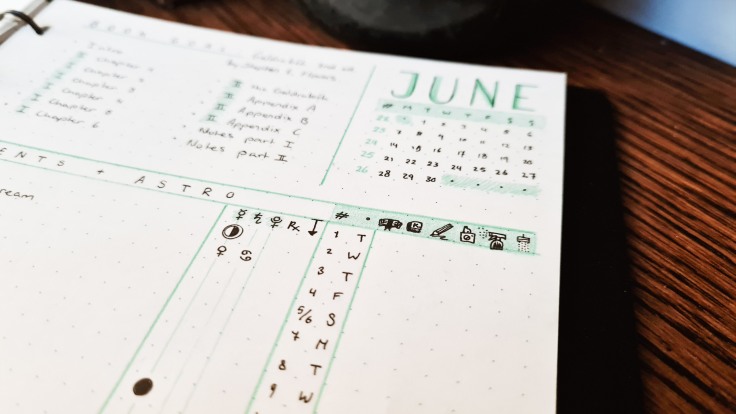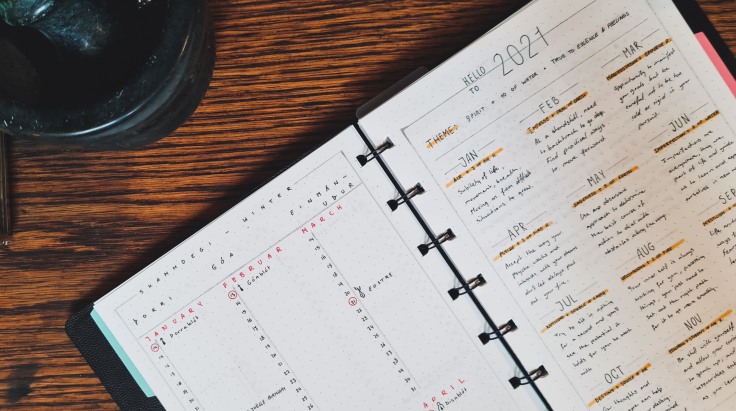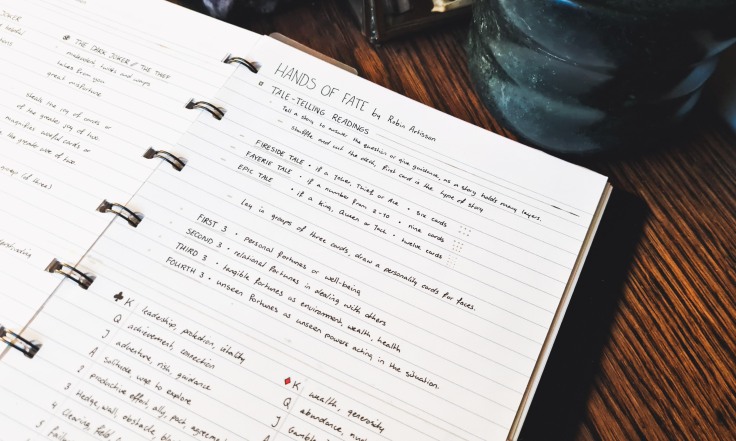It’s been a while since I last did a Mundane Magic blog, but as some of you all know, I’ve been restructuring my Bullet Journal practice since getting my Filofax Notebook and want to talk about how I incorporate my spiritual practice into it. I will go over both the planner as well as the journaling aspect of a bullet journal.
Sidenote, I’ve been struggling a bit with taking pictures and editing them properly since we’ve had a lot of rain lately and I’ve had to move to editing on my phone for reasons not worth mentioning here. Let me know if the quality bothers you at all or not.
The Journal
First off, as I’ve said in my Witchy 101 – Your Book of Magic, if doesn’t matter what kind of journal you use, as long as it works with the purpose you have in mind. Lined, (dot) grid, blank or digital, whatever suits your needs in a journal is what you should go for. It doesn’t need to be expensive or fancy, in fact, I personally recommend starting cheap and simple when you start of and try out things to determine what you prefer or not, to test the waters.
For me, a notebook I could add/remove pages to was important and thus I went with the Filofax notebook, but maybe a binder, travelers notebook or simple everyday notebook works better. Maybe you prefer your phone’s notepad or using a laptop or tablet. I am personally of the opinion physically writing is better than typing, but you should do what is best for you. If you are unable to write for whatever reason, speech to text may be of use to you.
Journaling

I’ve talked before about The Power of Words and how our words have weight and meaning that matters. Journaling helps us slow down and be present in the moment. Get things out of our head onto paper. When we journal our thoughts and feelings about our days, or different things, we give power and weight to what we put down. Not only does writing things down help us reflect on our lives, how we think and act versus how we (could) wish to handle situations, it also helps us process and reaffirm things.
Journaling our thoughts and ideas truthfully is important, even if they may be negative. Sometimes we need the power of our words in that sense to realize something. To accept how we actually feel about something, so we can move on and start to process it.
Perhaps you’ve seen the monthly shadow work prompts I’ve been posting on the blog. These can be a more spiritually guided way of journaling to include. Other ways of combining your practice with journaling could be writing about your card readings, meditations, prayers, spells and rituals. How the experience was, how they made you feel, how you think they could be improved upon, what they mean to you or how that meaning changed. Writing down experiences related to your practice can be a good way to reflect and see how your practice has developed over periods of time.
Bullet Journal

You’ve likely heard of a bullet journal. Characterized on social media by dot grid notebooks, artistic layouts and amazing penmanship. While these are note requirements for successful bullet journaling, they are common sight on social media. In fact, the bullet journal system was designed to be minimal effort with maximum output, the artistic expressions are simply people giving their own spin to things.
For those who have not been exposed to this phenomena, bullet journaling is a system that combines scheduling, note taking and brainstorming and other such things into a single notebook. Ryder Carroll is the one who developed the bullet journal system as is popular today, but people have been doing similar things to this for a long time. Ryder has written several helpful sources for you to look into yourself and give it a try. There’s a book about it, there’s notebooks made specifically for his system and there’s even an app.
In short, the bullet journal system uses a set of ‘key’ symbols, such as dots, circles, lines and crosses, that each refer to a different type of notation, like tasks, events, notes and tasks that have been completed, in progress or moved. There’s an ‘official’ key list, but you can easily add your own keys for things you need. Above you can see me use striped for notes, arrows for moving tasks, crosses for completed tasks, diagonal lines for tasks started but not finished and hooks that usually are brief journaling bits or side notes (further explained later on).
My Bullet Journal & Practice
I’ve been using a bullet journal for a few years now. It’s been kind of on and off, but my longest attempt at using it was during my years studying Media Design, using a Leuchtturm1917 dot grid notebook. It worked and there were a lot of things I enjoyed, but it wasn’t ideal to me. So November 2020 I invested into a Filofax Notebook.
The flexibility in use of the Filofax compared to the Leuchtturm has been a game changer. I can easily take pages out when making mistakes or wanting to archive them, move them around and refill the notebook with new inserts. I’m not limited to one type of paper and I can reorganize my pages however I see fit instead of being limited to a chronological order and having to index and number my pages.
My notes can now be kept separate from my day to day planning, for example, and its made the experience just feel more pleasant to me. I’m very much ‘organized chaos’ and this way I can bring a bit more structure to my journaling.
So, how do I work my practice into my bullet journal?

Astrology. I have recorded all the moon phases, transits and retrogrades for the year in a digital calendar and mark them into my monthly overview pages to keep track of them while I journal. This is also how I determine the dates for the Solstices and Equinoxes.
Books. Same goes for notes on books I’m reading. This goes for books on pagan and occult topics more than books in general, but I keep a list of books I (want to) read and then take notes of what I’m reading that I want to refer to later or that have some importance to me. I also keep book goals each year that I keep track of.
Collections. So, you may be aware that I have a relatively large divination deck collection. Well, I use my bullet journal to keep track of what decks I own, if I’ve edged them, trimmed them or made a pouch specifically for them, as well as if I’ve sold/re-homed them or not. I also keep a list of my books related to my practice separately, and a list of herbs, crystals and other such things you could call a collection.

Cycle. This is something I drop and pick up every now and then. Tracking my sleep, mood and/or my menstrual cycle according to astrology to see if there is correlation. It can be quite insightful if you’re into astrology, but I’m not very good at daily things and mood tracking isn’t as useful if you don’t do it regularly.
Divination. I have recently moved this to a separate Filofax journal BUT until now it has served me perfectly fine to just include daily, weekly or monthly readings into my pages with a brief interpretation. I ended up just wanting to keep track of them elsewhere. One those things I used to keep in my bullet journal was my yearly tarot spread (pictured above).
Holidays. I’m not ‘religious’ about the pagan wheel of the year, or the Ásatru calendar, but I’ve been wanting to keep track of certain Heathen holidays and relate current day to the old ways, so I’ve made a Primstav Calendar in my journal. It really is just a year overview with special days such as solstices and birthdays in a slightly different context than a normal year overview (pictured above).

Research. Whenever I have ideas or research I do for my practice, I write them down in my journal, effectively now making it double as a grimoire. This also includes courses I’m taking on various topics, such as herbalism and shadow work.
Side notes. This may sound a bit vague, but whenever something significant happened during my day I would make a small note of it. Be it something during meditation, the cry of a crow at the right time or a crystal or symbol I’m drawn to and carry that day. They are things I want to make quick note of so I can reference it or journal about later. I usually write these with an eye symbol.
Spells & Rituals. It’s been a while since I’ve done elaborate spell or ritual work (I tend to do so when I think it is necessary), but the times I have I would make either a side note or dedicate a page to reflect on it. I’d write down how I felt, intention, quick summary of the spell or ritual. This goes for many things, including incense blends, essential oils but also spell candles and sigils.
My favorite thing is that a bullet journal can adapt to your needs. So you can add, remove or adjust however you need it to. We grow, change and evolve, so does our practice and thus, so can our journal as we do so. It’s a combination of freedom & structure. When we have structure and few limitations we have the freedom to make it our own however we want or need.
Now that you know how I use my (bullet) journal alongside my practice, I’d be very interested in hearing how YOU incorporate a journal into your practice! Did I give you any ideas, or perhaps you have some ideas to share with me that I haven’t thought of yet. Feel free to reach out to me on Instagram or find me at The Open Woods Discord.
